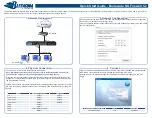
1.2 Linktropy Operation
The Linktropy Mini
2
and Mini-G emulate a wide area network link between two local networks.
Depending on configuration, the Linktropy device is installed as either a bridge or a router
between the Ethernet segments connected to the LAN A and LAN B ports of the unit. Frames
received on one port are subjected to the emulated WAN conditions before being forwarded to
the opposite port.
Frames are processed by the Linktropy WAN Emulator in the following steps:
1.
Ethernet frames arrive on the LAN A or LAN B interface of the Linktropy emulator.
2.
The effective size of the frame is calculated as the data portion of the Ethernet frame (without
the Ethernet header or FCS) plus the configured value for framing overhead.
3.
Frames are throttled to the specified WAN bandwidth. Frames in excess of the specified WAN
bandwidth are queued to the configured maximum queue depth. When the queue is full,
newly-arriving frames are discarded.
4.
Frames are subjected to random discard based on the configured packet loss and bit error
parameters.
5.
Frames remaining after the discard procedure are held for the specified link delay. Frames are
not reordered in this step, even if subjected to differing delays. For example, if the delay is
specified as a uniform distribution between 10 and 100 ms and the first frame is subjected to
a 90 ms delay and the second frame is subjected to a 20 ms delay, the second frame can not
be transmitted until after the first frame has been transmitted. This effect can skew the
measured mean delay to be higher than the configured value when using a normal or
uniform distribution.
6.
Frames are bridged or routed to the opposite LAN interface and transmitted to the
destination address.
Frames are subject to three separate delays:
1.
Propagation delay: Delay caused by the distance the signal travels. This delay is emulated as
the specified link delay.
2.
Queuing delay: If frames arrive faster than they can be transmitted over the WAN link, they
are held awaiting their slot for transmission. The actual queuing delay will vary depending on
how quickly frames arrive compared to how quickly they can be transmitted. The maximum
queuing delay is determined by the maximum queue depth, which can be set in milliseconds,
bytes, or packets.
3.
Transmission delay: The time to transmit the individual bits in each frame is an additional
delay that can be significant for large frames over low speed links. For example, the
transmission of a 1500 byte frame over a 9,800 bps link adds 1.25 seconds. The transmission
delay is fixed by the frame size and link bandwidth.
S
ECTION
1
O
VERVIEW
6







































